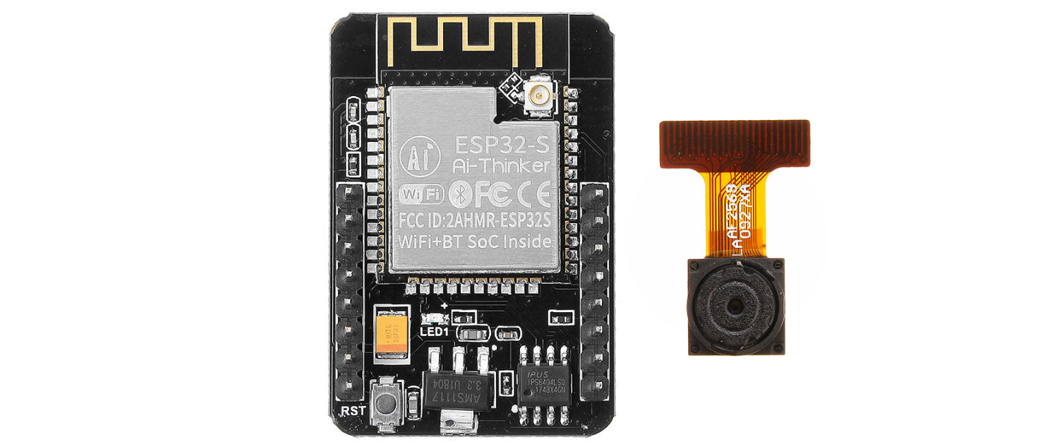What is ESP32
The ESP32 is a powerful microcontroller that’s designed specifically for IoT applications. It’s the successor of ESP8266 but with more capabilities and processing power. The ESP32 has two cores, which means it can handle multiple tasks at once, and it also has built-in WiFi and Bluetooth capabilities.
ESP32 features include:
- Dual-core 32-bit microcontroller
- 240 MHz clock frequency
- It includes WiFi and Bluetooth module
- Total flash memory of ESP32 is 4 MB
- It includes 520 KB of SRAM
Read here more about ESP32 and its pinout.
What is ESP32 Cam
The ESP32 Cam is a version of the ESP32 that’s designed specifically for camera applications. It has all the same features as the ESP32, but it also has a built-in camera module that allows us to capture and process images/videos.
ESP32 Cam features include:
- Dual-core 32-bit microcontroller
- 240 MHz clock frequency
- It includes WiFi and Bluetooth module
- 4 MB of flash memory
- 520 KB of SRAM
- OV2640 camera module with 2 megapixels
With these features, the ESP32 Cam is an excellent choice for projects that require camera functionality. We can use it to build security cameras, video doorbells, and more.
ESP32 Cam Features
- The ESP32 Cam features an onboard ESP32-S module that provides support for both WiFi and Bluetooth connectivity.
- It comes with an OV2640 camera.
- ESP32 Cam includes a TF card slot, the ESP32 Cam can support up to a 4G TF card that can store video and picture data.
- It is possible to monitor video over WiFi and upload images over WiFi using the ESP32 Cam.
- ESP32 Cam offers support for multiple sleep modes, including a deep sleep mode with a current as low as 6mA.
- The control interface of the ESP32 Cam is easily accessible through a pin header, making it simple to integrate and embed into a wide range of user products.
Specifications
The ESP32-CAM uses an ESP32 microcontroller chip along with the OV2640 camera module. Here are the technical specifications:
- Microcontroller: ESP32-D0WDQ6
- Flash Memory: 4MB
- PSRAM: 8MB (optional)
- RAM: Internal 512KB + External 4M PSRAM
- Antenna: Onboard PCB antenna
- Camera Module: OV2640
- Max Resolution: 1600 x 1200
- Image Sensor: 1/4 inch
- Pixel Size: 2.2 µm x 2.2 µm
- Field of View: 65 degrees
- Sensitivity: 600mV/Lux-sec
- Shutter Speed: 1/15 ~ 1/10000 sec
- Output image format: JPEG (OV2640 support only), BMP, GRAYSCALE
- External TF card: up to 4GB
- Operating Voltage: 5V
- Current Consumption: 250mA (max)
- WiFi: 802.11 b/g/n/e/i
- Bluetooth: v4.2 BR/EDR and BLE specification
- Interface: UART, SPI, I2C, I2S, PWM, GPIO
- Dimensions: 27mm x 40mm x 4.5mm
- Operating temperature: -20 ℃ ~ 85 ℃
- Storage environment: -40 ℃ ~ 90 ℃, <90%RH
Note that some of the technical specifications, such as the resolution and image sensor, may vary depending on the specific camera module used.
Is the ESP32 Cam Same as the ESP32?
The ESP32 Cam is not the same as the ESP32, which is a generic term for any board that uses an ESP32 chip. There are many different models of ESP32 boards, such as the ESP32 DevKit, the ESP32 WROOM, the ESP32 Feather, etc. Each board may have different features and peripherals, such as USB ports, microSD card slots, sensors, and displays.
One of the main differences between the ESP32 Cam and other ESP32 boards is that the ESP32 Cam has fewer I/O pins available. This is due to most of the ESP32 Cam pins being utilized by the onboard camera module and microSD card slot. Another difference is that the ESP32 Cam does not have a USB port, so you need an external FTDI adapter to program it.
Since the ESP32 Cam utilizes the ESP32 microcontroller, it possesses the same characteristics as the ESP32 board. It has the same dual-core 32-bit microcontroller, the same clock frequency, and the same amount of flash memory and SRAM.
However, the ESP32 Cam also has a built-in camera module, which sets it apart from the standard ESP32. So, in short, ESP32 Cam is not the same as ESP32.
Conclusion
The ESP32 board and ESP32 Cam are not the same however, the ESP32 Cam is based on the ESP32 chip. Both these boards share the same peripherals in many ways. The ESP32 is a microcontroller board with WiFi and Bluetooth support, while the ESP32 Cam comes with a built-in camera module. Read more on both these boards in this article.


